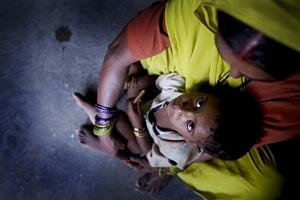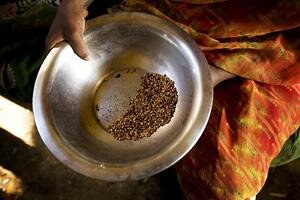Malnutrition Remains Major Killer in Nepal
Number of children with acute malnutrition remains near emergency levels despite decades of effort and millions of aid dollars.
 The number of children in Nepal with acute malnutrition hovers near emergency levels, something that has not changed even after 15 years of efforts and millions of dollars invested, say local and international nutrition experts.
The number of children in Nepal with acute malnutrition hovers near emergency levels, something that has not changed even after 15 years of efforts and millions of dollars invested, say local and international nutrition experts.
“The prevalence was the same in 1996. If we look at the number of children affected, the situation has even deteriorated due to the population increase,” said Nicolas Oberlin, deputy country director of UN’s World Food Programme (WFP).
Levels of wasting - acute malnutrition, or low weight-to-height ratio - hardly changed from 2006 to 2011, according to the Nepal Demographic and Health Survey 2011 (DHS).
Any global acute malnutrition rate- comprising both moderate and severe acute malnutrition-exceeding 10 percent is considered a nutrition emergency, according to medical experts. As of 2011, the Department of Health (DOH) estimated wasting affected nearly 11 percent of children under five years old, or 385,000 children. Some 2.6 percent of all under-fives – 91,000 – had severe acute malnutrition.
In Nepal, malnutrition plays a role in 60 percent of child deaths, according to UN Children’s Fund (UNICEF).
“We are concerned about making more children vulnerable if we don’t act fast,” Raj Kumar Pokharel, chief of the DOH nutrition section, told IRIN, acknowledging that the government, until now, has not paid enough attention.
While most children with wasting are in the remote hills of Midwest and Far West regions, considered the poorest areas nationwide, severe acute malnutrition, the situation is worse in the southern fertile plains bordering India, known as the western Terai. There, more than 15 percent of children are estimated to be acutely malnourished due to poor sanitation, contaminated water and water-borne disease outbreaks during monsoons, according to the government.
In addition, the rate of stunting (low height-for-age, also known as chronic malnutrition) in Nepal is among the world’s highest; UNICEF reported this year that Nepal has the sixth worst rate of stunting - 49 percent - among all countries that provided data.
Below, IRIN explores five reasons experts have identified as the main culprits behind Nepal’s stubbornly high malnutrition rates.
Poor health
Acute respiratory infections and diarrhoea, Nepal’s leading causes of deaths among children under age five, are linked to acute malnutrition, according to the Ministry of Health and Population. Diarrhoea depletes children of critical nutrients and makes them more vulnerable to infection; infections, in turn, worsen their nutritional status.
In 2011, there were 2.7 million cases of acute respiratory infection reported to the government. Of the 1.7 million reported cases of diarrhoea, only 38 percent of the children saw a healthcare provider.
Of those who sought healthcare, half were treated with oral rehydration salts (ORS). In 2012, an independent evaluation of Nepal’s health system noted that zinc, recommended by the World Health Organization for diarrhoea treatment in conjunction with ORS and proven to cut diarrhoea-related deaths by some 40 percent, was not widely distributed.
Poor sanitation
 More than three million of the country’s 30.4 million people do not have access to safe drinking water despite the country’s abundant fresh water resources. Nearly 19 million do not have access to “improved sanitation”-public standpipes, covered wells or springs, piped household connections or boreholes -according to the local NGO Forum for Water and Sanitation.
More than three million of the country’s 30.4 million people do not have access to safe drinking water despite the country’s abundant fresh water resources. Nearly 19 million do not have access to “improved sanitation”-public standpipes, covered wells or springs, piped household connections or boreholes -according to the local NGO Forum for Water and Sanitation.
“A big cause of malnutrition is our poor health environment due to the poor hygiene practices, poor sanitation and…poor living conditions,” said nutrition expert Som Paneru, president of the Nepal Youth Foundation, which runs nutrition treatment centres nationwide.
Poor access to safe drinking water and sanitation facilities are associated with skin and diarrhoeal diseases, as well as acute respiratory infection.
Poor early childcare practices
“The critical period [for a child] is during the 1,000 days from pregnancy up to two years of age. Whatever damage is done to physical growth and brain development during the period is very difficult to reverse,” said Saba Mebrahtu, chief of UNICEF’s nutrition section in Nepal.
“Childcare practices are really poor, and usually we find that babies are not fed nutritious food, especially after six months,” explained government official Pokharel.

















